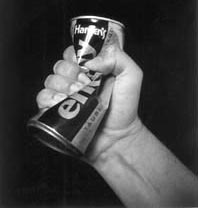![[MetroActive Dining]](/gifs/dining468.gif)
[ Dining Index | Sonoma County | MetroActive Central | Archives ]
X-Drinks
America is warming up to those caffeinated energy drinks--no bull!
By
TIM SCHROCK works hard. Then he plays hard. Then he works some more. An avid soccer-player and full-time grocery manager at the upscale Petaluma Market, Schrock--like most of us--needs a little energy boost now and then just to keep focused and moving. He used to depend on coffee, several cups a day, but eventually got sick of it.
"Literally," he says straightforwardly. "The stuff gave me the jitters."
Now when he's working a long shift at the store, or preparing for a big soccer match, he'll reach, not for a cup of joe, but for a nice cold energy drink.
That's right. An energy drink. The kind that come in those cute little cans.
You've seen them, in the markets or local health clubs, in the student union at the college, or in the brown-bag lunch of some guy you know at work. The tiny little beverages with the funny names--Red Bull, Merlin's Elixir, Nitro Glycerine, XTC--and a great big fully caffeinated wallop to the adrenal system.
These beverages, weighing in at an average 7.7 ounces per sleek and slender can, have been slowly nudging their way into American hands, after a full decade of phenomenal popularity in Asia and Europe. Introduced to the states only about three years ago, energy drinks arrived in the conspicuous form of XTC--marketed not as a drink, but as a "carbonated slap in the face"--a product of Liechtenstein.
Originally aimed at affluent baby boomers, serious athletes, and extreme-sports types, the market has changed directions as dozens of other companies have trotted out their own versions of what they like to call "functional beverages." You don't drink them for the taste or to quench your thirst, you see; functional beverages have to do something to you, preferably something you feel all the way to the tip of your toes.
What's the Buzz? Local experts sample a collection of buzz-making nectars and offer their straight-shooting opinions
Though the drinks are kind of pricey--around $1.50 a pop--their main consumer, according to industry reports, is now your basic working stiff (especially truck drivers, late-shift employees) and college students.
Packed with caffeine--often derived in part from a face-slapping Amazonian root called guarana--the drinks also feature medicine cabinets full of vitamins and other supplements and legal energizers. In Asia--where those tiny little cans originated (even Coca-Cola is sold in the downsized version)--the drinks are all the rage among the working class, whose long hours mean massive fatigue. Last year in Thailand, the government allowed a 30 percent increase in the drinks' caffeine level, just to give the workers an extra boost.
And a boost they do give.
Most of the drinks carry warnings meant to scare off diabetics and people with heart problems.
"I'll put it this way," says Shrock. "They work."
For the record, his personal favorite is an all-organic version called Cinagro Energy Plus, the best-selling energy drink in the store. "All the drinks sell pretty well," says Schrock, "though obviously not compared to water or juice or soda or coffee. But we've designated an entire four-foot shelf to our energy drinks. They definitely warrant the space."
Energy drinks have found their way into fitness clubs and gymnasiums as well.
"They're very popular in the gym," says Chuck Mignosa or Gold's Gym in Santa Rosa. "Real popular. People do use them as a pick-me-up, like coffee, to give them the energy for a workout. Those drinks do work--they really give you the energy to train on."
Gold's sells several varieties. According to Mignosa, though, most of the athletes he trains prefer to skip the "soda pop" energy drinks, reaching instead for products like Blue Thunder, Nitro Glycerine, or Zero Tea--beverages specially designed to stimulate while offering additional supplements to build muscle and burn fat.
Not everyone is charmed by the little cans, however.
Dan Harvey, a night-shift supervisor at a Marin County newspaper, says the energy drinks are too sweet--and too expensive--for his taste. "I don't care how much caffeine they have in them," he says. "Give me a good strong cup of coffee and I've got all the energy I need."
[ Sonoma County | MetroActive Central | Archives ]
Copyright © Metro Publishing Inc. Maintained by Boulevards New Media.
![]()

Photograph by Michael Amsler
![[line]](/gifs/line.gif)
![[line]](/gifs/line.gif)
From the October 28-November 3, 1999 issue of the Sonoma County Independent.